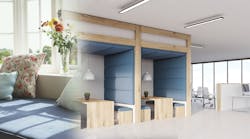Close your eyes, breathe deeply and imagine a place where you would be happy to be alone, where you would feel inspired and nurtured, a place where you feel alive. For many, the image that emerges is connected to a residence, maybe a nook under the stairs or a treehouse in the backyard, revealing a natural humanistic inclination to home as a place of dwelling and an expression of the self.
This translates to Stanley Abercrombie’s 1977 theory that feelings for or about nonresidential interiors “will inevitably be colored by our first interior experience, the residential one.” Unfortunately, a common connotation associated with residential design is that it’s somehow less than the design of commercial spaces. Its practice isn’t driven by myriad codes to protect the health, safety and welfare of occupants, and licensure isn’t required to practice in many states. In 2017, residential design made up only about five percent of the market sector for the top 100 design giants and brought in $184 million in fees. While these facts may seem a logical rationale for limiting residential design education to a comparable percentage, that would be a premature dismissal of a rich breeding ground for studying empathy, user-centered design and the human experience.
Literature has shown that design trends in non-residential applications have become increasingly focused on a user-centered design approach, considering the well-being and satisfaction of occupants.
“The coming decades are all about user experience,” said design firm Gensler in 2017. Commercial projects are expected to see continued focus on the user experience in the coming years. What’s more, resimercial trends that are characterized by a blending of commercial space with residential qualities, indicate a broad desire for shared spaces that embody the values historically ascribed to the home.
Listen to I Hear Design with your Favorite AppsThe 2017 CIDA Summit Report supports the inclusion of empathy-generating educational experiences as a means for deeper learning, and several accreditation standards support this emphasis. The expanded focus on social justice, empathy and needs of humanity is evident across the entire discipline of interior design, all of which can be explored through study of residential spaces at their inception and the notion of home.
Many scholars have studied the concept of home and interior design, however, looking beyond the discipline to the framework provided by Claire Cooper Marcus in House as a Mirror of Self: Exploring the deeper meaning of home, allows for a more meaningful and theoretical exploration. Marcus challenges occupants to connect the soul with place of inhabitance. Her close examination of immersion with residential spaces suggests soul nurturance, engaging in a dialog with the environment and active listening for establishing a connection to space, all of which align with design theory for residential and commercial application.
Perhaps a home-centered design process is the next logical step in the evolution of design practice. Such a model would utilize residential design’s historical basis in user theory as a tool for examining spaces that may not be residential, but demand qualities of home.
As Abercrombie stated, “entering an interior, therefore, is, to some small degree, always going home.” Hence, by reimagining residential spaces as the impetus of user-centered design, perhaps residential design can overcome its less than connotation and once again be regarded as equal to commercial design.
In this regard, the result isn’t about architecture, decorating or real estate, but rather the bonds and feelings people possess with places of dwelling. In a world focused on the deeper influences of space on culture, occupant outlook and overall well-being, it follows that the study of people in their most intimate spaces, their homes, provides an original yet unique model for transformative design.
Stephanie Sickler is an assistant professor in the Department of Interior Architecture and Design at Florida State University and Helen Turner is an assistant professor in the College of Design and the University of Kentucky.
Next Up: Creating Unique Glass Lighting Fixtures | Inside the New Sandy Hook






